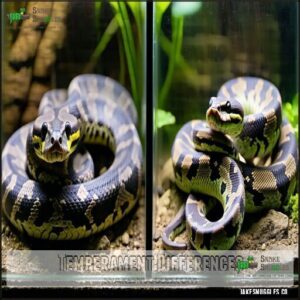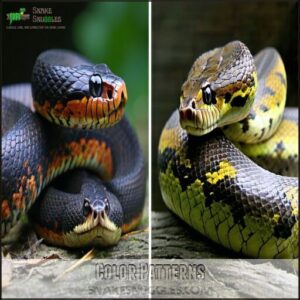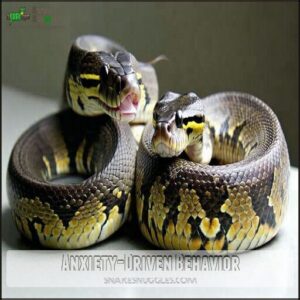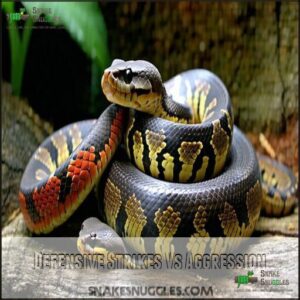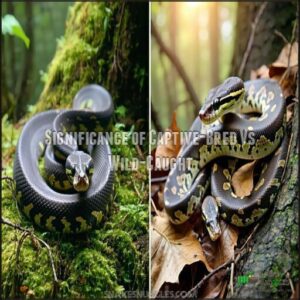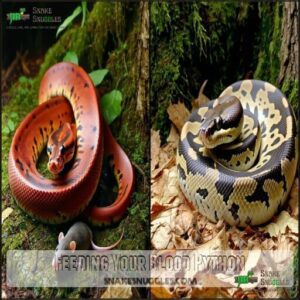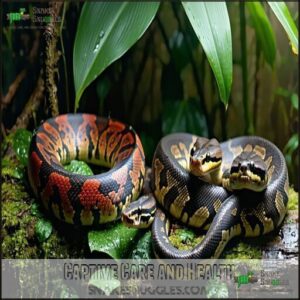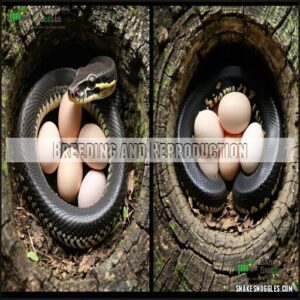This site is supported by our readers. We may earn a commission, at no cost to you, if you purchase through links.
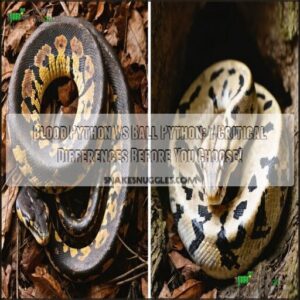 When comparing a blood python vs ball python, size and temperament are key.
When comparing a blood python vs ball python, size and temperament are key.
Blood pythons are stocky, reaching up to 8 feet, with bold red patterns, but they can be moody, requiring confident handling.
Ball pythons, on the other hand, stay smaller—around 3-5 feet—and are famously shy, often curling into a ball when stressed (hence the name).
Care-wise, blood pythons need higher humidity and space, while ball pythons are easier for beginners, making them the mellow option, in contrast to the spicy nature of blood pythons.
Choosing the right fit depends on your experience and comfort level with snakes.
Table Of Contents
- Blood Python Vs Ball Python
- Blood Python Behavior
- Creating a Calm Environment
- Feeding Your Blood Python
- Blood Python Natural History
- Captive Care and Health
- Breeding and Reproduction
- Frequently Asked Questions (FAQs)
- What is a blood python?
- Are ball pythons good pets?
- What is a ball python?
- How big is a ball python?
- Are ball pythons venomous?
- Are blood pythons a good pet snake?
- Are blood pythons friendly?
- How aggressive are blood pythons?
- What’s the difference between a python and a ball python?
- What is the difference between a ball python and a blood python?
- Conclusion
Blood Python Vs Ball Python
You’ll find distinct differences between blood pythons and ball pythons that substantially impact your choice as a snake owner.
Blood pythons are stockier, potentially more aggressive snakes from Southeast Asia that require specialized care.
Ball pythons are known for their docile nature and beginner-friendly temperament from West African habitats.
Size Comparison
Looking at the physical dimensions between these python species reveals vital differences for potential owners.
The following table highlights the key physical differences:
| Feature | Blood Python | Ball Python |
|---|---|---|
| Weight | 15-30 pounds | 3-5 pounds |
| Length | 5-8 feet | 3-5 feet |
| Girth | Substantial | Moderate |
Blood pythons are like muscular tanks, with their impressive girth and hefty weight making them more challenging to handle. Their substantial size requires larger enclosures with ample floor space rather than height.
Blood pythons are muscular tanks with impressive girth and hefty weight, requiring larger enclosures with ample floor space rather than height.
Ball pythons, by contrast, maintain a more manageable profile both in length variation and weight differences. They’re perfect starter snakes if you’re concerned about space constraints or handling difficulty.
Remember, a python’s size directly impacts your long-term care commitment and enclosure requirements.
Temperament Differences
Beyond their size differences, temperament truly sets these pythons apart.
While having similar scientific names, their personalities couldn’t be more different.
| Behavior Trait | Blood Python | Ball Python |
|---|---|---|
| Default Mood | Anxious, defensive | Calm, docile |
| Under Stress | May strike quickly | Curls into a ball |
| Handling Challenge | Moderate to high | Low |
Blood pythons aren’t necessarily aggressive—they’re typically nervous and quick to defend themselves when feeling threatened.
Their bite frequency decreases substantially with consistent, gentle handling.
Ball pythons earn their "beginner snake" reputation through their docility genetics.
They’re remarkably tolerant of handling mistakes that would trigger defensive responses in other species.
"My blood python transformed from a hissy missile to a lap snake in three months," reports one keeper.
From defensive strikes to gentle cuddles, my blood python became the ultimate chill companion with consistent, patient handling.
Captive taming requires patience, but the results are worth it.
Care Requirements
After considering temperament, let’s examine the care requirements for both snake species.
| Care Factor | Blood Python | Ball Python |
|---|---|---|
| Enclosure Size | 4’x2′ minimum | 3’x2′ sufficient |
| Humidity Control | 60-70% consistently | 50-60% range |
| Temperature Gradient | 78-82°F precise | 75-92°F flexible |
Blood pythons demand specialized care with pristine water changed daily to prevent respiratory issues.
Ball pythons forgive temperature fluctuations better, making them ideal starter snakes for beginners seeking lower maintenance with a more flexible temperature range.
Color Patterns
The color patterns of blood pythons and ball pythons often influence a keeper’s decision when choosing between these species.
While blood pythons display rich crimson, copper, and burgundy tones with striking scale iridescence, ball pythons offer greater genetic variations with over 7,000 documented pattern morphs.
| Feature | Blood Python | Ball Python |
|---|---|---|
| Color Intensity | Deep, rich reds and browns | Varied, from earth tones to vibrant designer colors |
| Pattern Morphs | Limited but dramatic | Thousands of combinations available |
| Camouflage Purpose | Swamp and forest floor blending | Grassland and savanna concealment |
Both species showcase remarkable patterns that serve natural camouflage purposes while enchanting reptile enthusiasts. The blood python’s intense coloration contrasts with the ball python’s diverse pattern possibilities, giving keepers distinct visual experiences.
Habitat Preferences
Beyond their striking appearances, blood pythons and ball pythons require distinctly different habitats to thrive.
Your blood python evolved in Southeast Asia’s rainforests and swamps, requiring high humidity levels and moist substrates. Ball pythons, however, hail from African grasslands where conditions are considerably drier.
| Habitat Feature | Blood Python | Ball Python |
|---|---|---|
| Humidity Needs | 60-70% | 50-60% |
| Temperature Gradient | 78-82°F | 75-85°F |
| Burrowing Behavior | Frequent | Occasional |
"My blood python transforms whenever I mist his enclosure," one keeper shared. "The humidity triggers his natural instincts immediately."
When setting up your enclosure, remember that blood pythons need larger floor space rather than height for proper burrowing in natural substrates. They’ll appreciate water features that mimic their native Southeast Asian wetlands—something your ball python won’t need, as they have different habitat needs.
Blood Python Behavior
You’ll find that blood pythons display more anxiety-driven behaviors than their ball python cousins, often responding defensively when stressed.
Understanding their body language helps you distinguish between genuine aggression and normal defensive reactions, which is essential for successful handling and care.
Anxiety-Driven Behavior
Many snake owners misinterpret their blood python’s actions as aggression when they’re actually witnessing anxiety-driven behavior. Unlike the docile ball python that curls into a defensive ball when stressed, your blood python may strike out of fear rather than malice.
Understanding behavioral cues helps implement effective stress reduction techniques:
- Watch for rapid breathing, tense muscles, and defensive posturing – signs your snake feels threatened
- Notice if your python retreats quickly when approached or exhibits frequent striking behavior
- Observe whether handling sessions result in consistent defensive responses
Both species experience anxiety, but their temperament training requires different approaches. Blood pythons need consistent, gentle handling techniques to build trust, while ball pythons generally adapt more quickly to human interaction.
Captive breeding has substantially improved blood python temperament over generations, making today’s specimens generally less reactive than their wild-caught ancestors.
Defensive Strikes Vs Aggression
Building on what we’ve learned about anxiety behaviors, it’s essential to distinguish between true aggression and defensive strikes in blood pythons.
Your blood python isn’t striking because it’s mean—it’s reacting out of fear. Unlike ball pythons, which curl into a defensive ball, blood pythons lack alternative protection mechanisms.
When feeling threatened, they employ striking as their primary defense. Understanding strike triggers (like sudden movements or high temperatures above 85°F) helps prevent bites.
With consistent, gentle handling experience, your blood python’s temperament will improve over time.
Despite common species myths, defensive behavior isn’t true aggression—it’s simply your python saying "I feel unsafe.
Importance of Proper Husbandry
While defensive strikes may look scary, proper husbandry transforms a blood python’s behavior completely. Your snake’s true personality only emerges when its environment meets all needs.
Unlike ball pythons who forgive minor care mistakes, blood pythons demand precision in their python care routine.
- Temperature management: Keep a 78-82°F gradient with quality thermostats for ideal health monitoring
- Humidity control: Maintain 60-70% humidity through strategic misting for proper shedding
- Enclosure enrichment: Provide multiple hides, climbing branches, and sturdy water dishes
- Substrate selection: Use cypress mulch or coconut husk that holds moisture without molding
Think of blood python husbandry as running a five-star snake hotel—when their basic needs are met, they check out of "Grumpy Town" permanently. Your consistent attention to these details supports their long-term wellbeing and makes handling techniques much more pleasant for everyone involved.
Significance of Captive-Bred Vs Wild-Caught
The origin of your snake greatly impacts its behavior.
Beyond proper husbandry practices, choosing between captive-bred and wild-caught specimens can make all the difference in your experience.
Captive-bred blood pythons typically offer more stable temperaments than their wild-caught counterparts.
While wild-caught specimens may retain their natural defensive instincts, captive-bred snakes are often acclimated to human interaction from birth.
Ball pythons, known for their generally calm and docile nature, also benefit from captive breeding.
| Factor | Captive-Bred | Wild-Caught |
|---|---|---|
| Temperament stability | Generally calmer | Often defensive |
| Health advantages | Fewer parasites | Higher disease risk |
| Conservation impact | Supports ethical sourcing | May harm wild populations |
When selecting your blood python or ball python as a pet snake, captive-bred specimens support conservation efforts while typically providing a more rewarding ownership experience.
Creating a Calm Environment
You’ll need to establish specific environmental conditions for your python’s health and happiness, with blood pythons requiring higher humidity (60-70%) than ball pythons.
The right setup, including proper temperature control, hiding spots, and enclosure design, will reduce stress and prevent defensive behaviors in both species.
Optimal Temperature Range
Four precise temperature zones create a calm environment for your blood python.
Unlike their ball python cousins, blood pythons require strict thermal management:
- Set basking spots at 84-88°F with reliable heating gradients for proper digestion
- Maintain cool side temperatures between 75-78°F for thermoregulation options
- Allow night temperatures to drop to 76-78°F, mimicking natural cycles
- Monitor seasonal adjustments with accurate thermostats in each zone
When temperature ranges are perfect, your blood python will explore more and hide less.
They’re particularly sensitive to temperature fluctuations—what might just stress a ball python could seriously impact your blood python’s health.
A quality thermostat is essential for maintaining these temperatures.
Proper python care starts with getting these heating requirements right, ensuring a calm environment and accurate thermostats for your pet’s well-being, which is crucial for its overall thermal management.
Humidity Levels
Maintaining proper humidity levels for your blood python can make all the difference in their health compared to ball pythons.
While ball pythons thrive at 45-55% humidity, blood pythons need 60-75% to mimic their swampy origins.
For effective humidity management:
- Position multiple calibrated hydrometers throughout the enclosure
- Use moisture-retaining substrates like cypress mulch or coconut husk
- Implement regular misting techniques during dry seasons
- Create a humidity gradient with dampened substrate on one side
When humidity drops too low, you’ll notice shedding problems and potential respiratory infections. Using a reptile hygrometer is essential for monitoring these levels. Think of proper humidity as your snake’s daily spa treatment—essential for both physical health and psychological comfort.
Enclosure Design
With ideal humidity in place, you’ll need the right enclosure design to keep your blood python comfortable.
Your snake needs a spacious home – blood pythons require larger enclosures than ball pythons due to their stockier build. Choose a tank with at least 4 square feet of floor space with secure, escape-proof lids.
Use cypress mulch or coconut husk as substrate. Create a proper thermal gradient (78-82°F) using heat pads or panels mounted on one side.
Many options are available to help you design your enclosure. Remember, proper python care means prioritizing security and comfort in your snake enclosure design.
Hiding Places and Security
Now that you’ve designed your enclosure’s layout, let’s focus on your blood python’s security needs. Unlike the more relaxed ball python, blood pythons require multiple hiding spots to feel truly comfortable.
Your python will thrive with:
- At least two snug hides (one warm, one cool) where they can touch all sides
- Cork bark flats or hollow logs that allow for natural burrowing needs
- Black hide boxes that block light completely, reducing stress
- Thick substrate layers (3-4 inches) for a blood python’s instinctive digging
- Secure, escape-proof lids with locks—they’re stronger than they look!
When a blood python feels safe, they’re less likely to strike defensively. Think of hiding spots as your snake’s personal security system—essential for both physical and mental wellbeing.
Ventilation Considerations
When setting up your python’s home, proper ventilation balances airflow importance with humidity control.
Your snake’s health depends on this delicate balance.
| Feature | Blood Python | Ball Python |
|---|---|---|
| Humidity Needs | 60-70% | 50-60% |
| Ventilation Methods | Side and top vents | Top mesh panels |
| Mold Prevention | Critical | Important |
Install strategically placed vents in your snake enclosure to prevent respiratory infections while maintaining moisture.
Blood pythons require more humidity than ball pythons, but both need adequate airflow to prevent stagnant conditions.
Think of ventilation as your snake’s fresh air system—it’s not just comfort, it’s essential.
Feeding Your Blood Python
You’ll need to understand your blood python’s slower metabolism compared to ball pythons, which affects how often you should offer food.
Unlike ball pythons that eat weekly, your blood python will thrive on a feeding schedule of once every 10-14 days to prevent obesity and maintain peak health.
Metabolic Rate
Your blood python’s metabolic rate works like a slow-burning engine, drastically different from what you might expect.
These cold-blooded creatures process food at a pace tied directly to their environment, affecting their digestion efficiency and energy needs.
Unlike mammals that burn calories quickly, your blood python conserves energy masterfully. This explains why they eat far less frequently than similarly-sized warm-blooded animals.
- Food remains in their digestive tract 3-5 days longer than in mammals
- Energy expenditure drops by 60% when temperatures fall below ideal range
- Growth rate increases up to 30% during warmer seasons
- Shedding frequency correlates directly with metabolic activity
- Temperature impact can double or halve digestion speed
Understanding this metabolic pattern helps you create the perfect feeding schedule for your python’s unique needs.
Feeding Schedule
After understanding their slower metabolism, you’ll need to establish an appropriate blood python feeding schedule. Unlike the weekly meals ball pythons typically require, your blood python needs less frequent feeding.
Young blood pythons do best with appropriately-sized meals every 10-14 days. As they mature, extend the feeding frequency – adult males only need one properly-sized rat every 2-3 weeks.
This python feeding pattern prevents obesity while meeting nutritional needs. Watch for regurgitation issues, which often signal feeding too frequently or offering prey size that’s too large.
Prey Items and Variety
Now that you’ve established a feeding schedule, let’s look at what’s actually on your blood python’s menu.
Blood pythons have a stronger feeding response than their ball python relatives, making prey selection a bit more straightforward. They’re generally less finicky than ball pythons, who can sometimes refuse meals for weeks.
For ideal nutrition, consider these feeding approaches:
- Offer appropriately sized prey (1.5-2× your snake’s mid-body width) to prevent digestion issues
- Rotate between rats (primary diet) and occasional quail or day-old chicks for dietary enrichment
- Always use frozen-thawed prey for safety, thawing thoroughly before feeding
Your blood python will benefit from this variety, which mimics their natural diet in Southeast Asian rainforests. Unlike ball pythons, they rarely refuse properly prepared meals, making feeding time less stressful for both of you.
Overfeeding Risks
While proper nutrition is essential, overfeeding your blood python can lead to obesity dangers that ball pythons typically don’t face as severely.
Your python’s distinctive metabolism makes it prone to fatty liver disease and organ damage.
Overfeeding risks include regurgitation, digestive issues, and significant lifespan reduction. A blood python can double in girth when overfed!
Monitor portion sizes carefully—your snake’s health depends on your restraint, not your generosity.
Blood Python Natural History
You’ll find blood pythons naturally inhabiting the swampy lowlands and rainforests of Southeast Asia, primarily in Thailand, Malaysia, and Indonesia where they’ve adapted as nocturnal ambush predators.
They’ve successfully adjusted to human-modified environments like plantations, showing remarkable resilience despite ongoing habitat loss throughout their native range.
Native Habitat
Explore the native soil where blood pythons originally slither.
These fascinating reptiles emerge from the steamy landscapes of Southeast Asia, contrasting sharply with ball pythons’ African grasslands origin.
Blood pythons have perfectly adapted to:
- Humid lowland swamps and marshes throughout Thailand, Malaysia, and Sumatra
- Dense Asian rainforests where humidity rarely drops below 70%
- Muddy riverbanks and forest floors ideal for their ambush hunting style
- Palm oil plantations where human impact has created new rodent-rich territories
These swamp specialists thrive in environments most humans would find unbearably muggy.
Their natural habitat’s high humidity levels have shaped their care requirements in captivity.
When you’re setting up an enclosure, remember: you’re trying to recreate these Southeast Asian conditions, not the drier African grasslands their ball python cousins call home, which is a critical consideration for their well-being and requires a deep understanding of their natural habitat and humidity needs.
Adaptation to New Environments
Beyond their native swamps, blood pythons have demonstrated impressive adaptation to new environments. These resilient creatures have successfully inhabited oil palm plantations across Southeast Asia, showcasing their environmental flexibility.
When bringing a blood python into captivity, you’ll notice behavioral shifts during their adjustment period. Unlike ball pythons that adapt more readily to captive life, blood pythons require specific environmental enrichment to thrive.
Create a habitat that mimics their natural surroundings with consistent humidity (60-70%) and proper temperature gradients. Optimal setups require careful temperature monitoring for snake health. This approach substantially improves captivity success and supports long-term health.
Start handling sessions brief and gentle, gradually increasing duration as your snake becomes comfortable. While adapting to dietary changes, blood pythons may initially refuse meals—this is normal during environmental transitions. Remember that patient acclimatization leads to a calmer, healthier snake that will reward your efforts with fascinating natural behaviors.
Ambush Predators
The blood python has perfected its role as an ambush predator through thousands of years of evolution. Unlike their ball python relatives, these Southeast Asian hunters excel at patient, calculated attacks.
Their nocturnal hunting style makes them especially effective after dark.
- Their strike speed can reach lightning-fast velocities, giving prey almost no chance to escape
- Masters of camouflage tactics, they blend perfectly with forest floor debris until the perfect moment
- They’re selective in prey selection, typically targeting small mammals that match their size capabilities
- Their heat-sensing pits provide remarkable sensory adaptations for detecting warm-blooded creatures
You’ll notice blood pythons rely more heavily on their muscular build when subduing prey compared to ball pythons. They’ll remain motionless for hours, conserving energy until the perfect moment to strike. This patient approach to hunting separates them from many other snake species, making them highly effective nocturnal hunters.
Lowland Swamp Areas
When you look at blood pythons in their native habitat, you’ll find them thriving in lowland swamp areas of Southeast Asia.
Unlike ball pythons who prefer drier environments, blood pythons have evolved specifically for wetland living.
| Feature | Blood Python | Ball Python |
|---|---|---|
| Habitat | Lowland swamps | Dry grasslands |
| Water Need | High moisture | Moderate |
| Prey Abundance | Water-adjacent animals | Terrestrial rodents |
"If it’s soggy, I’m happy!" might be your blood python’s motto. Their entire biology depends on swamp biodiversity and water quality.
Their unique adaptation to such environments is a key factor in their survival, making conservation of these areas crucial for the species’ well-being.
Captive Care and Health
You’ll need to monitor your python’s health closely as different species have unique care requirements that directly impact their wellbeing.
Blood pythons demand higher humidity and larger enclosures with multiple hiding spots, while ball pythons can tolerate more varied conditions but still need proper temperature gradients to prevent respiratory infections.
Stress and Health Impact
Moving from their natural habitats to your care, pythons face unique challenges that impact their health.
Your blood python or ball python will show clear signs when stressed:
- Food refusal – They’ll skip meals when environment feels wrong
- Defensive striking – Not aggression, but a stress response
- Breathing issues – Listen for wheezing or watch for nasal bubbles
- Incomplete shedding – Often caused by humidity problems
- Excessive hiding – Beyond normal reclusive behavior
Captive-bred snakes typically handle enclosure stress better than wild-caught specimens.
Since pythons mask illness until severely progressed, your husbandry practices directly prevent stress-related illnesses. Regular health checks help catch shedding problems early.
Remember, your snake’s environment is their entire world – proper handling stress management through correct temperature, humidity, and quiet surroundings promotes ideal snake health in captivity.
A stressed snake may also exhibit increased aggression.
Cage Size and Footprint
Your blood python’s enclosure requirements differ substantially from a ball python’s needs.
While ball pythons can thrive in smaller spaces, adult blood pythons demand at least a 4ft x 2ft footprint for proper Space Utilization.
Choose quality Cage Materials with adequate ventilation systems to maintain ideal conditions.
Blood pythons prioritize floor space over Vertical Space, as these terrestrial creatures rarely climb.
An appropriately sized snake enclosure directly impacts your python’s health—cramped quarters lead to stressed snakes.
When comparing python size differences, remember that blood python enclosures require more substantial dimensions, affecting Long-Term Costs of Enclosure Enrichment.
Paper Layers and Hiding Spots
Every blood python requires strategic hiding spots that differ substantially from their ball python cousins.
Proper substrate choice and security needs directly impact your snake’s stress levels.
When setting up your snake enclosure:
- Layer paper substrate 2-3 sheets deep for maximum moisture control and easy weekly cleaning
- Position hiding boxes on both warm and cool sides to accommodate temperature preferences
- Make certain hideaways are snug enough for complete concealment but spacious enough for comfortable burrowing behavior
- Include varied materials like cork bark, commercial hides, and plant saucers for enclosure enrichment
Blood pythons display higher hiding frequency than ball pythons, often seeking security throughout the day.
A well-decorated habitat with multiple retreat options reduces defensive behaviors and promotes natural activities.
Remember, your chunky python isn’t being antisocial—they’re simply following instincts that keep them feeling safe and comfortable.
Dehydration and Shedding Issues
After setting up proper hiding spots, you’ll need to monitor your python’s hydration and shedding health.
Your python’s skin tells you everything about their health. While blood pythons need 60-70% humidity, ball pythons require 50-60% to shed properly.
Watch for these shedding trouble signs:
- Retained eye caps that don’t come off with the rest of the skin
- Patchy, incomplete sheds that look like peeling paint
- Dull, wrinkled scales lacking their usual shine
- Discolored belly scales during the shedding process
- Refusal to eat as shedding approaches
Never try to pull stuck shed off forcibly!
Breeding and Reproduction
You’ll notice significant differences in breeding behaviors between blood pythons and ball pythons when starting your breeding project.
Blood pythons reach sexual maturity at 3-4 years and produce fewer but larger eggs, while ball pythons mature earlier at 2-3 years and typically lay 4-8 smaller eggs per clutch.
Age and Health Requirements
While preparing your pythons for breeding, understanding their age and health requirements is essential for success.
The lifespan and breeding age of the two species differ:
| Comparison | Blood Python | Ball Python |
|---|---|---|
| Lifespan | 25-30+ years | 20-40 years |
| Breeding Age | Females: 4+ years, Males: 18+ months | Females: 3+ years, Males: 18+ months |
Both species are prone to certain health issues:
For juvenile care, both species need consistent monitoring during growth periods. Adult health depends on proper nutrition and environment.
Remember that ball pythons often require less frequent veterinary visits than blood pythons, but both benefit from annual check-ups. Your python’s health directly impacts breeding success—no shortcuts!
Breeding Pairs and Introductions
Selecting compatible breeding pairs is the foundation of successful python breeding. For both blood pythons and ball pythons, choose healthy specimens with clear eyes, clean vents, and proper weight.
Before introductions, implement strict quarantine protocols (30-45 days) to prevent disease transmission between snakes. This step is crucial for the health and safety of the animals.
When ready for breeding, place the male in the female’s enclosure—never the reverse. Blood pythons require more space during introductions than ball pythons due to their larger size and temperament.
Monitor initial interactions carefully, watching for signs of stress or aggression. To stimulate breeding, consider how pheromone trails aid selection.
Avoid hybridization risks by never housing different python species together during breeding season. Proper introduction techniques substantially increase your breeding success rate, making them a vital part of the process.
By following these guidelines and taking the time to ensure healthy specimens and proper breeding conditions, you can significantly improve your chances of successful breeding.
Female Ovulation and Egg-Laying
Female blood pythons display distinctive ovulation signs that serious breeders should monitor during snake reproduction.
When female blood pythons approach egg-laying, you’ll notice:
- A pronounced mid-body swelling that develops 4-6 weeks before eggs appear
- Dramatic color intensification, with scales becoming noticeably brighter
- Complete food refusal as her body prioritizes egg development
- Increased movement as she searches for suitable nesting sites
Blood pythons typically produce larger clutch sizes (12-30 eggs) compared to ball pythons (3-11 eggs). Expect egg-laying approximately 30-45 days after successful ovulation, with proper incubation methods essential for maintaining egg fertility.
Frequently Asked Questions (FAQs)
What is a blood python?
A blood python is a non-venomous snake from Southeast Asia, known for its stocky build, reddish-brown coloration, and muscular frame.
It thrives in humid environments like swamps and rainforests, hunting rodents, birds, and reptiles, which showcases its ability to survive in various humid environments.
Are ball pythons good pets?
Did you know ball pythons are the most popular pet snakes worldwide?
Their calm nature, manageable size, and simple care needs make them perfect for beginners.
They’re like the “starter pack” of snake ownership!
What is a ball python?
A ball python is a non-venomous snake from West Africa, known for its calm temperament and compact size.
It’s a popular pet choice, often curling into a ball when feeling threatened—hence the name!
How big is a ball python?
Picture a rope coiled neatly on the ground—ball pythons typically grow 3 to 5 feet long.
They’re compact, with a slim build, making them manageable for most beginners and perfect for smaller enclosures.
Are ball pythons venomous?
No, ball pythons aren’t venomous.
They’re constrictors, meaning they wrap around prey to subdue it.
If you’re worried about bites, don’t stress—these snakes are known for their gentle nature and calm demeanor.
Are blood pythons a good pet snake?
If you’re experienced with snakes, blood pythons can make fascinating pets.
They’re strikingly beautiful but require patience, precise care, and regular handling to stay calm.
Their size and temperament might challenge beginners, so plan accordingly to ensure you can provide the proper care for your blood pythons.
Are blood pythons friendly?
Around 80% of blood pythons can be aggressive, especially when stressed.
They’re not naturally “friendly,” but with consistent, patient handling, many become calmer over time.
Think of them as moody roommates needing space and respect!
How aggressive are blood pythons?
Blood pythons can be temperamental, often striking when stressed or startled.
Their strong, defensive nature means handling requires patience and confidence.
With consistent care, they may become calmer, but they’re not naturally docile snakes.
What’s the difference between a python and a ball python?
A python is a broad term for non-venomous constrictor snakes, including ball pythons.
Ball pythons are a specific species, smaller and more docile, making them popular pets, unlike their often larger python relatives.
What is the difference between a ball python and a blood python?
You’ll notice ball pythons are smaller, calmer, and easier to handle, making them beginner-friendly.
Blood pythons, on the other hand, are larger, heavier, and can be temperamental, requiring more experience and careful handling.
Conclusion
Choosing between a blood python vs ball python is like picking between spice and sweetness.
Blood pythons, bold and hefty, demand confident handling and higher care.
Ball pythons, smaller and shy, curl up when stressed, making them beginner-friendly.
If you’re ready for a challenge, blood pythons offer striking beauty and personality. Prefer mellow? Ball pythons fit the bill.
Your experience, space, and comfort level will guide the choice. Both snakes are fascinating, but their needs differ greatly, requiring confident handling.


